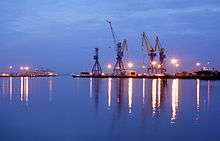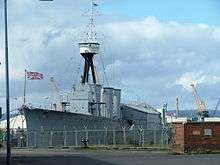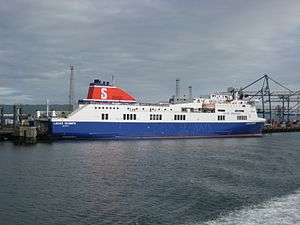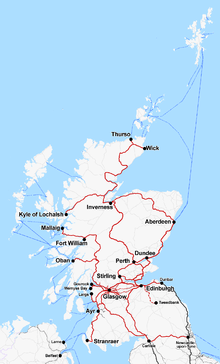Belfast Harbour
Belfast Harbour is a major maritime hub in Northern Ireland, handling 67% of Northern Ireland’s seaborne trade and about 25% of the maritime trade of the entire island of Ireland. It is a vital gateway for raw materials, exports and consumer goods, and is also Northern Ireland’s leading logistics and distribution hub.
The Belfast Harbour Estate is home to many well-known Northern Ireland businesses such as George Best Belfast City Airport, Harland and Wolff, Bombardier Aerospace, Odyssey, the Northern Ireland Science Park, Titanic Quarter and Titanic Belfast. Over 700 firms employing 23,000 people are located within the estate.
Belfast is only one of two ports on the island of Ireland to handle a full range of cargoes, from freight vehicles to containers, dry, break and liquid bulk, as well as passenger services and cruise calls.
Belfast Harbour handled 23 million tonnes of cargo during 2015, similar to its throughput for 2014. The tonnages suggest a varying performance between sectors in the wider Northern Ireland economy.

History
Belfast Harbour's origins date back to 1613 when a Royal Charter for the incorporation of Belfast specified the need for a wharf at the confluence of the rivers Lagan and Farset in what is modern-day Belfast’s High Street.
Records show that by 1663 there were 29 vessels owned in Belfast with a total tonnage of 1,100 tonnes. Trade continued to expand throughout the century, to the extent that the original quay was enlarged, to accommodate the increasing number of ships.
By the early 18th century Belfast had replaced Carrickfergus as the most important port in Ulster and additional accommodation was necessary. A number of privately owned wharves were subsequently constructed on reclaimed land. Throughout the century trade continued to expand as Belfast assumed a greater role in the trading activities of the country as a whole. In 1785 the Irish Parliament passed an act to deal with the town's burgeoning port. As a result, a new body was constituted: The Corporation for Preserving and Improving the Port and Harbour of Belfast, commonly called 'the Ballast Board'.
Although already well established by this stage, the Port remained disadvantaged by the natural restrictions of shallow water, bends in the channel approach and inadequate quays. These problems, together with an increasing volume of trade, led to a new government act of 1837 under the Westminster Parliament. This reconstituted the Board and gave it powers to improve the port, through the formation of a new channel. Initial work on straightening the river commenced in 1839 and by 1841 the first bend had been eliminated. Thus beginning the creation of what was to become known as the Victoria Channel.
In 1847 the Belfast Harbour Act repealed previous acts and led to the formation of the Belfast Harbour Commissioners. This new body, with much wider powers, completed the second stage of the new channel two years later. From that time the Commissioners have developed and improved the Port, reclaiming land to accommodate new quays, new trades and changes in shipping and cargo-handling technology.

During World War II the Port of Belfast was used by the Royal Navy as the home base for many of the ships that escorted Atlantic and Russian convoys including Captain-class frigates of the 3rd Escort Group. HMS Caroline is a First World War light cruiser permanently berthed in Belfast Harbour and currently serves as the training ship for some 130 reservists as the headquarters for the Ulster Division Royal Naval Reserve. She is the second oldest commissioned warship in the Royal Navy.
Belfast West Power Station (formerly Power Station West) was opened in 1961 on a site in the port subleased to the Belfast Corporation Electricity Department. This subleased is today held by Northern Ireland Electricity. The station continued to generate electricity until its closure in March 2002. On 6 July 2007 the station's three 240 ft (73 m) chimneys were demolished by controlled explosion and the remainder of the site was cleared in the following months.[1] The site continues to be managed by NIE on behalf of the utility regulator which has stated that the various conditions of the lease "suggest that the best use for the site going forward is electrical generation."[2]
Management
Belfast Harbour is one of the UK's many "Trust Ports" and is an independent statutory body. Trust Ports are not owned by Government; they are obliged to operate independently and on a commercial basis. Its Board – known as Belfast Harbour Commissioners - is appointed by Northern Ireland’s Department for Regional Development on the basis of open public advertisement.
The Commissioners currently number fifteen and are led by a Chairman. The positions are remunerated and are for terms of three years. All of the Commissioners with the exception of the Chief Executive are non-executives.
Board members
The current Commissioners (February 2016) are:[3]
David Dobbin (Chairman), Roy Adair (CEO), Kyle Alexander OBE, Diana Fitzsimons, Deborah Lange, Jane Chambers, Richard Everitt, Councillor Sonia Copeland, Councillor Mervyn Jones, Alderman Frank McCoubrey, Councillor Ciaran Beattie, Rotha Johnston CBE, Dr Gerard O'Hare CBE, DL, Christine Hayes and Dr Ed Vernon OBE.
Law enforcement
The port is patrolled by the Belfast Harbour Police, which is one of the oldest constabularies in the British Isles, dating back over 160 years.
In recent times the service has faced new challenges as the relocation of marine facilities to the seaward end of the Port have created opportunities to develop new residential, commercial and public spaces. In addition to traditional port users the Harbour Police now provide a range of policing services to tenants, residents and visitors who frequent the Harbour Estate.
Operations

Freight
In 2014 476,000 freight vehicles used the Port, a 2.2% increase over 2013. Stena Line's Belfast-Stanraer route and Belfast-Heysham service together carried 307,000 freight vehicles. This figure represents 20% of the Irish Sea Ro-Ro market. 125,000 containers and 6.0 million tonnes of bulk cargo were handled in 2009.[3]
Stena Line now runs between Belfast and Cairnryan.
Passenger services
1.4 million passengers used the port's ferry services in 2014. Routes from the Port of Belfast include:
- Stena Line to Cairnryan. Stena discontinued its operations to Stranraer in 2011 in favour of new ferries, MS Stena Superfast VII and MS Stena Superfast VIII, sailing to its new port at Cairnryan.
- Stena Line to Birkenhead. Stena bought this operation from DFDS, renaming the two ships MS Stena Lagan and MS Stena Mersey.
- Isle of Man Steam Packet Company to Douglas, Isle of Man
Ferry & Rail Connections
Connecting Belfast with Glasgow Central via Stranraer using the bus link from Cairnryan. Trains run along the Glasgow South Western Line from Stranraer to Glasgow Central.
| Preceding station | |
Following station | ||
|---|---|---|---|---|
| Historical railways | ||||
| Ferry Connections | ||||
| Stranraer Harbour (via bus link from Cairnryan[4]) |
Stena Line Ferry |
Terminus (nearest stations Yorkgate, Belfast Central & Belfast Great Victoria Street) | ||

There is Metro bus Service 96 connecting with Yorkgate onto the Londonderry Line and Belfast Suburban Rail network of Northern Ireland Railways.
Cruise ships
It is increasingly popular with cruise liners, with 2016 due to be the busiest cruise season in the city’s history with over 145,000 passengers and crew due to visit, representing a 26% increase in visitor numbers compared with 2015.
The 2 cruise berths that are used are the Pollock dock for smaller ships and the Stormont Wharf (deep water berth) for larger ships, The extended Stormont Wharf was opened on 30 June 2009 by the Grand Princess.
Pollock Dock: (Length 457m, depth 8.5m) Stormont Wharf (Length 177m, depth 10.2m)
Property
Belfast Harbour has extensive property interests coverint about 1,950 acres (790 ha). 855 acres are used directly for port operations, 90 acres (360,000 m2) are reserved for nature conservation and the remaining 1,005 are either leased or under negotiation.[5]
Titanic Quarter

Belfast Harbour's largest property project is the Titanic Quarter, which is "co-promoted" with Titanic Quarter Limited.
Holywood Exchange

Belfast Harbour Commissioners and its partners made the first planning application for Holywood Exchange (previously known as D5 or Harbour Exchange) on 14 November 1995. Planning permission was granted twice and then successfully challenged. The third time planning permission was granted it was again challenged, but this time unsuccessfully. Construction began in December 2002 and when completed the development consisted of an 11 unit 13,940 m2 (150,000 ft2) retail warehouse centre, a Sainsbury's store and service station, and a B&Q store. A 29,000 m2 (312,000 ft2) IKEA store opened on 13 December 2007.
Other
The Odyssey Complex, which consists of the Odyssey Pavilion, SSE Arena Belfast and W5 is a large sports and entertainment centre situated in the Belfast Harbour Estate. The Odyssey arena and pavilion is built on land owned by The Odyssey Trust under a 150-year lease with Belfast Harbour Commissioners.[6]
See also
| Wikimedia Commons has media related to Port of Belfast. |
References
- ↑ Tall chimneys come down to earth
- ↑ Consultation on Vacant Sites within the NIE Land Bank Archived 25 July 2011 at the Wayback Machine. 13 May 2010
- 1 2 Belfast Harbour: The Board Archived 6 January 2015 at the Wayback Machine.
- ↑ http://www.dumgal.gov.uk/CHttpHandler.ashx?id=13006&p=0
- ↑ "New law raises questions about future of key asset and island's second-largest port". The Irish Times. 25 March 2008.
- ↑ http://theodyssey.co.uk
External links
Coordinates: 54°37′04″N 5°54′06″W / 54.61778°N 5.90167°W
